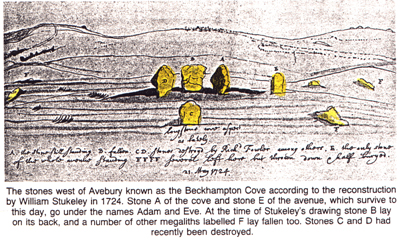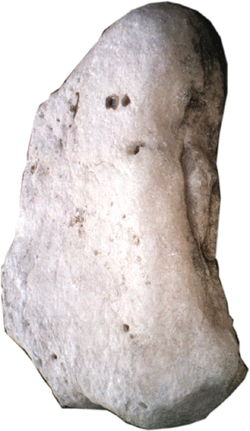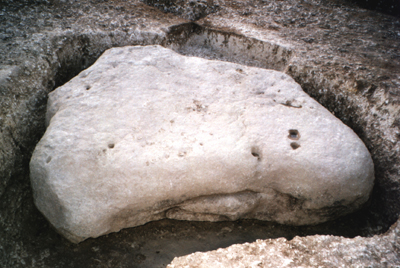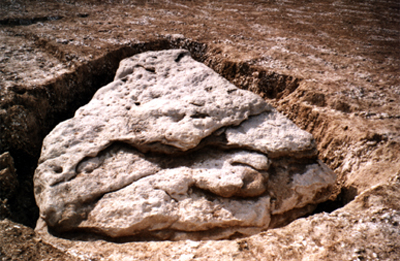Beckhampton Avenue
and Cove

In 1724 William Stukeley was the first commentator
to describe the remains of the Beckhampton Avenue and Cove.
For hundreds of years the local farming community - influenced
by the teachings of an uncomprehending Christian Church - had
been destroying this great monument. The Avenue which
leads westwards from Avebury - or rather perhaps, eastwards into Avebury
- was built by an ancient British tribe in the third millennnium BCE as
part of the enormous Avebury megalithic complex. When completed,
there were approximately a hundred megaliths along its course if the number
bears comparison with that of the south-running Kennet Avenue (an overall
plan of these avenues in the Avebury landscape is given on the page for
Avebury's neighbouring sites).
His sketch of the megaliths (Stones A B C and D) of the
4-stone Cove at Beckhampton reveal an orientation aligned on the midwinter
sunrise. That is to say at the winter solstice the rising sun casts
the shadow of Stone C upon the central Stone B. Today only Stone
A survives, but the position of the stone-hole (in the subsurface chalk
bedrock) of the missing Stone C has been detected by geophysical
search methods.
Stukeley's drawing shows another standing stone
labelled Stone E which is a stone of the lost Avenue. This megalith,
together with A, survive to this day as standing stones. They are
called the Longstones. Stukeley's drawing includes additional Avenue
stones which he saw as fallen stones (marked F F F F
etc) to the east and the west of the Cove.
Besides this, Stukeley narrates the recent history
of Avenue megaliths which followed the course of the High Street in Avebury
(W. Stukeley, Abury, published 1740). A detailed summary has been
given by Terence Meaden as Chapter VVV of his book The Secrets of the
Avebury Stones (published in July 1999) in which Dr Meaden predicted
that one day the course of the missing avenue would be rediscovered.
Amazingly, by the start of September 1999, Stukeley's statements
about the presence and the course of the Avenue as it neared Beckhampton
Cove were proved correct when an excellent team of archaeologists from
university departments in Southampton, Leicester, Newport and Newcastle
began unearthing megaliths that had been buried hundreds of years earlier.
Photographs of two of the stones are supplied below, while
additional photographs and discussion are given on our Avebury news pages.
Beckhampton Avenue: The Newly-found Stone (F 25)
 ................
................ This stone is shown on its side as found in the burial pit, and again in
a vertical position, to indicate how it would look if raised on its base.
This stone is shown on its side as found in the burial pit, and again in
a vertical position, to indicate how it would look if raised on its base.
Newly-found Stone F 22



................
This stone is shown on its side as found in the burial pit, and again in
a vertical position, to indicate how it would look if raised on its base.